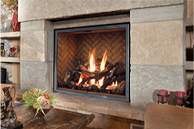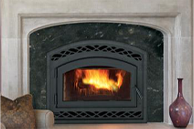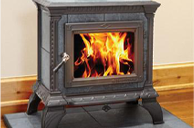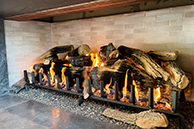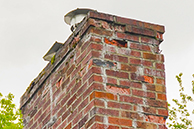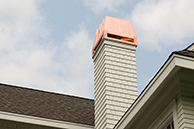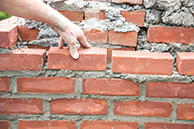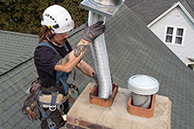Get Your Chimney Ready For Fall
As the weather cools down and the days seem to get shorter, you may be itching to get back to cozy fires at night. There is nothing like the glow and warmth of a fire with friends or family members. However, with every new season, it’s important to make sure your chimney is ready for another burn season. Let’s look at some steps to take to get your chimney ready for the fall.

Step 1: Chimney inspection
Every chimney should go through an annual chimney inspection and cleaning. Many people get this out of the way right after the burn season in the spring; however some homeowners wait until late summer or early fall. Either option work just fine as long as it gets scheduled and completed ahead of your first fire.
Our chimney professionals will get their eyes on every inch of the chimney — inside and out. They will make sure to look for obvious broken pieces as well as the beginning signs of things such as cracked mortar, loose bricks, or any other small gaps or hairline fractures. Catching these things early can avoid leaks or bigger issues down the road. Next, they’ll ensure all debris is cleared out and take care of creosote build-up. Once these steps are taken care of, you’ll be on your way to a toasty winter season.
Step 2: Stock up on proper firewood
Some people think that any old wood lying around could be used for indoor fires. However, that is not necessarily the case. Certain firewood types burn less cleanly and are more apt to produce creosote buildup. Typically, these types of wood are a soft wood variant, such as pine, spruce, or fir. Additionally, you want to avoid pressure-treated lumber, painted, or stained wood. These can release harmful chemicals into the air that are best left unburnt.
So, what kind of firewood should you use? It’s important to gather wood that has been split and dried, also referred to as seasoned. This makes for less smoke, less creosote buildup, and burns more efficiently. You’ll want this wood to have been seasoned for at least 6 months to a year, depending on the type. Oak, maple, and birch are the best firewood options.

Step 3: Burn a trial fire
Lastly, in your clean chimney, assemble a test fire with the above-mentioned wood variants. You’ll want to make sure your damper is open to see how your draft is flowing. If smoke is going up and out your chimney, you’re likely in good shape. If you notice it coming into your room, you likely have a draft issue and may need some professional assistance.
Call Twin City Today
Prepping your chimney for the fall may require assistance from chimney professionals at Twin City. Our expert team can assist with maintenance to get you back up and running or help with any repairs that may come up over the years. Call us with any general chimney and fireplace questions you may have, or to schedule an appointment with a certified chimney sweep today.
 Active-Duty Military Owned
Active-Duty Military Owned
